Frank Hurley - Sydney Photographer:
the early years as a professional photographer
In 1911 Frank Hurley was a Sydney commercial photographer, known amongst the profession and the amateur societies for his enthusiastic and energetic approach to making the “Perfect Picture”. During the year he had re-established a studio following several years of work in photography and publishing which had seen a huge production of photographic postcards as well as involvement in publishing materials for stationery and other goods involving photography.
Later in 1911 his career was about to undergo a major change of direction when he took the opportunity of a life-time and one which would deliver the move onto the world stage. The coming events were signalled to the world when the editor of Australasian Photo-Review reported that:
J. F. Hurley Joins the Mawson Antarctic Expedition as Official Photographer
"Mr. J. F. Hurley, so well-known to Sydney photographers, and for some time past associated with Sydney depot of Kodak Ltd., has been selected to accompany the Mawson Expedition as official photographer. Both parties have reason to be satisfied with this arrangement, in as much as Mr. Mawson secures the services of a thoroughly capable and efficient photographer upon whom he may rely at all times, and Mr. Hurley is given an opportunity such as comes to few men.
He is now in his twenty-sixth year, and took to the study of the photographic art some twelve years ago. At that time the camera was but a hobby which was enthusiastically indulged in. The outcome was the adoption of photography as a profession five years ago. Mr. Hurley’s work has been generally admired, not only for its technical excellence, but also for its originality of conception and departure from the conventional.
He has given considerable time to research work and the application of photography to scientific purposes, and is a keen enthusiast in cinematography. Endowed with such qualifications, Mr. Hurley should certainly prove of great assistance to Mr. Mawson in his Expedition. We feel sure that we voice the sentiments of the photographic fraternity in wishing Mr. Hurley “Bon voyage and good luck.”
James Francis Hurley (Frank Hurley) 1885 - 1962
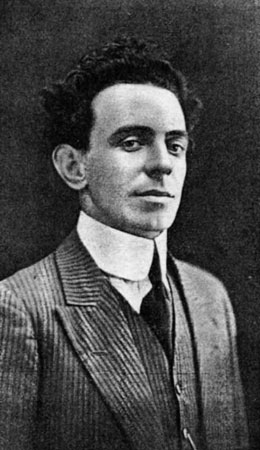 |
The story of Frank Hurley’s early professional life as a photographer, previous to his departure with Douglas Mawson for the Antarctic, has been very much overshadowed by the well documented and much published stories about his later life and adventures.
As with most creative people, Frank Hurley's early years were crucial to setting work practices which were to underpin his more famous achievements later in his long career. The early period of his life in Sydney is intertwined with the world of photography at end of the 19th and the beginning of the 20th Centuries.
Frank Hurley was not a revolutionary in his work, but there is little doubt that he was quick to pick up on available techniques and develop them into a distinctive style. Much of the documentation on Frank Hurley’s early life and work has been derived from versions of stories, told by Frank Hurley himself.
Primary research soon reveals some doubts about the accuracy of some of these storylines. Research has also revealed clues and pieces of information on Mr J F Hurley and his work as well as about some of his associates and collaborators. In the exercise of building a story worth telling, our man has been extremely successful in being the marketing manager of his own biography.
Many writers on Hurley have been subject to Frank’s own spin-doctoring and you have to admire anyone who can achieve such a success in promotions, with the effect lasting well after he died in January 1962. |
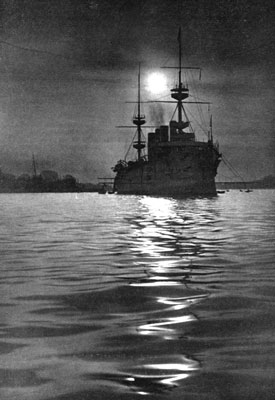
Vigil of the Night, J F Hurley


|
It is possible that Hurley would have gone on to become just one more Sydney professional photographer. Though given his nature, his energies and his eye for the opportunity, this is doubtful. Following this announcement, Hurley would go onto to enter the history books alongside other photographers, filmmakers and adventurers.
While the Photo-Review editor gave the readers of 1911 a short version of Frank Hurley’s curriculum vitae, I suspect, as with all such press releases, that Frank Hurley wrote and submitted the original version. In doing so, he probably did what he was to continue to do for the rest of his life, ensured that he used any opportunity to market himself in the most positive light.
The editor’s statement established the point at which the stories about Frank Hurley vary. This happens to such an extent that it is now difficult to verify certain parts of the Frank Hurley story. This is not to say that the whole story about Frank is not fascinating. Nothing could be further from the truth.
After all, do you know anyone who has in one lifetime managed to do the following:
- Produced postcards of Sydney and Australia in the early 1900s.
- Was a significant member of several Camera Clubs, with his greatest impact being as a member of the Ashfield Camera Club, whose patron was the explorer and scientist, Professor Edgeworth David.
- Was a constant presenter to Sydney camera clubs in and around 1910.
- Joined Mawson on his most famous trip to the Antarctic.
- Travelled into Northern Australia in a Model-T Ford in 1914.
- Travelled through Papua New Guinea and the Torres Straight Islands.
- Joined Shackelton on the "Endurance" and was stranded in the Antarctic for two years.
- Was official photographer in Flanders and Palestine in World War One.
- Married a beautiful opera singer in Cairo and return to Australia and raised four children.
- Flew with Ross and Keith Smith.
- Held numerous exhibitions of photographs.
- Wrote a book or two.
- Produced films.
- Toured Australia several times giving lantern slide lectures.
- Was awarded the Antarctic Medal.
- Returned to the Antarctic with Mawson two more times.
- Worked with Cinesound Australia during the 1930s.
- Attempted to break the Sydney to London flight record (unsuccessfully in 1928)
- Worked with the ABC.
- Was in the Middle East during World War Two.
- Was awarded the Order of the British Empire (the first photographer to be awarded)
- Travelled all over Palestine.
- Travelled Australia extensively by car over many years.
- Produced many illustrated books about Australia from 1948 to his death in 1962.
- Produced Australiana cards and calendars in the 1950s.
- Built and cared for his own extensive gardens with complex ponds and native plants.
- Produced booklets on Australian native plants. (he was specialist on native flora).
- And all the while produce a life-time's worth of photographic images.
|
Here's an overview and introduction to Frank Hurley, the marvellous story about his early years and, of course, some of his early photographs.
The Professional Photographer
Australia at the end of the 19th Century had its share of established professional photographers with both national and international reputations.
The most well known professional was the ‘Studio Photographer’ who used a variety of methods to entice clients to come into the studio for their likeness to be made. Clients regarded highly the professional who delivered a favourable likeness. The photographic truth, as we now regard it, was not the issue. Retouching, hand colouring and other forms of manipulation, including composites, were highly praised as sort after enhancements to images captured by the photographer.
The studio photographer had an eager marketplace and the profession flourished. Some professionals covered public events and rapidly produced the images into a public market place that was learning to rely on the photographers for news.
In the last years of the 19th Century, there was a downturn in business in Australia caused by drought and financial depression but the demand for photographs continued. The more highly successful gathered clients from the rich, the successful and the local nobility. Many city studios were opened during the last and first years of the 19th and 20th Centuries and many of these were often celebrity occasions, with some being opened by the Governor or the Premier. These more fortunate photographers were the ‘society photographers’ whose ‘art-photography’ was very much prized. The photographers of this ilk were celebrities, whose movements were reported in the press of the day.
Many of the photographers before and after the turn of century participated in the ‘views trade’ whereby images were made as a record of lifestyles, occupations, businesses and domesticity and to impress folks back home, that is England, of the successes of new nation. Not forgetting that in the 19th Century, Australia also had a healthy number of émigrés and visitors from the United States, China, and other Europeans such as Germans and Dutch. There was a mix of nationalities amongst the professional photographers and their clients. A variety of accents would have been heard in the studios
These travelling photographers blitzed the cities, the regional centres and the countryside making and selling images. The arrival of a travelling photographer was seen as an important event within a country town, with progress through the streets, from building to building, home to home, business to business, often being reported in the local newspapers.
Enter Frank Hurley, the Professional Photographer
Frank Hurley most likely commenced his professional career somewhere around 1904 to 1905.
Frank told the story that he became interested in photography earlier, around 1900 during his spare time while in Lithgow as an assistant in the ironworks. There are indications that a professional interest may have commenced later, around 1904 to 1905, through an association with Henry Mallard, an assistant in Harrington’s Photographic store in George Street and an active amateur photographer.
Because of this link to the trade, Frank most likely was able to access all the journals available to both amateurs and professionals. Whenever he did take to the medium as a professional, there is no doubt that he did so with complete commitment and application.
All indications are that he consumed all available the written material and transferred his trade competencies from electrical and ironwork to a high level of inventiveness in using and adapting the contemporary film, chemicals and equipment. This was very common amongst the photographers of the time.
Photography in the 19th Century was linked very much to chemists and those interested in experimenting with chemicals for use in photography. The off-the-shelf chemical mixes were still in their infancy and photographers spent much of the work life mixing, and inhaling, a range of chemicals. Of course, some of the mixes brought an early end to the lives of many photographers as well as being partly responsible for the fires that often burnt down photographers’ studios.
Hurley seemed to have enjoyed the challenges of having to use ingenuity to solve chemical and mechanical problems involved with taking and producing photographs at this time.
Frank Hurley and the Photo Postcard
| It was in the early years of the 20th Century that governments in Australia finally let go of restricting the shape of the reverse of the postcard and allowed this side to be completely taken up by an image, with the front being split for the address and message.
Previously, the front was for the address only, thus creating competition between the message and the decoration or image on the back. Printers and photographers in Sydney, as they had done worldwide, rose to the occasion and joined in putting photographic images onto the back of these cards. Today when we examine these cards, we now regard the image as the front and the message as being on the back.
In their time, the postcard was a cheap form of communication and with several postal deliveries a day, an effective one equivalent to making a phone call today. Hence the message on the front is often just a greeting, sometimes a notice that someone is going to visit, sometimes news and often just a note to say hullo. On some occasions, the card was sent just to provide another PC (postcard) for the receiver’s collection.
By coincidence, a bakery was established on the corner just down from the Hurley’s towards 1900 and it seems that there has been one there every since. The house one back from the corner, is number 63, is presently connected internally to the corner two story building, the baker, and is the one often mistaken for the original Hurley household.
The school that Hurley attended is situated within sight at the southern end of the street. This school, like all at the time, would have suffered from most pupils not attending regularly. In fact most children seemed to have spent more time away from school than in school. Given the work to be done around the home and in family businesses, many would have been encouraged to stay home and contribute. Most left school at age 13 or 14. Few students progressed beyond this age at school. One notable exception would have been a student named Douglas Mawson who attended school around the same time as Hurley but did so across the other side of the estate at Forest Lodge. |
|
One postcard of note is a card written by Frank Hurley’s own mother to one of Frank’s brothers, Henry. The note is fairly typical of card sent within the family.
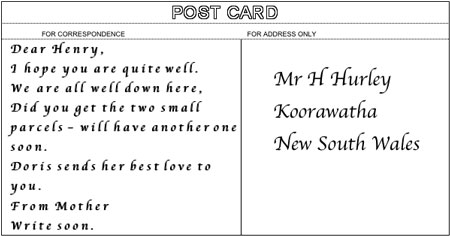
As viewed on a postcard in the Robert Mills’ collection.
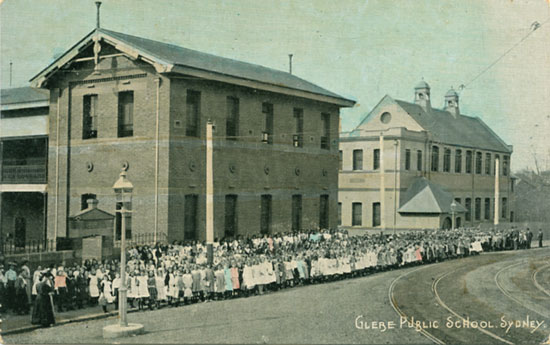
|
James Francis Hurley and early employment
The story of Franks’ exit from school as told by Hurley himself is colourful, involving a fight with the teacher, hoping aboard a train, being caught at a Blue Mountain’s station and ending with him finding work at a Lithgow Ironworks. There is little doubt that he left school, along with most students, at the early age of about 14.
Where he ended up next remains to be confirmed, however, at some stage he seems to have worked at Lithgow and somewhere around or after 1900 he learnt some trade skills in electrical and ironwork. While it is fairly certain that during these years, Frank was away from home for some of the time, it seems that he did keep contact with the family and most probably returned to live with them in Derwent Street or at the house they moved to in Forest Lodge.
Frank has written much about his life but his immediate family belong to another world that he left out of his records. For instance he has little to say his four siblings and what happened to them. Records show that the family moved from their home in Derwent Street to another smaller house in the next suburb of Forest Lodge. Hurley senior died suddenly in 1907. The Typographers Association marked his death with a statement in the press honouring his contributions to the printing profession.
During the first few years of the century, Frank Hurley seemed to have had several jobs and continued his education. The employers were The Ironworks, possibly some firm at darling harbour and later he is on record as having worked with the Post and Telegraph Department, possible the GPO itself, which places him geographically in the same location as where his first photographic career was to be centred.
Becoming Professional
There is also some evidence that Frank attended a Sydney Technical School and became quite skilled in matters electrical. Later he was reported to say that he had attended Sydney University. This is not quite correct. It is possible that he ‘attended’ the University for work or possibly a training program, however he had no formal university qualification. We can only speculate that he needed later to be seen to be educated formally rather than to admit his humble education. But having said that, there is no doubt that Frank Hurley did in fact become a very educated and to some extent a scientific person, be it through self-education. He lacked any formal tertiary qualifications, and of course, this was common amongst many successful people of this and later times.
During these years his interest in photography grew. One often quoted version is that when Frank Hurley was 17 he became interested in photography and purchased his first camera, a Kodak Brownie, which he paid it off at a shilling a week, a lot of money for a boy of seventeen. His interest grew till he reached the point where his ‘day job’ interfered with his interests. Or to follow the line within the Frank Hurley story-line, his employer, the Post and Telegraph Department, realised Frank’s dedication was elsewhere, and asked him to leave.
By about 1905, Frank was under the influence of others, most importantly his friend, Henri Mallard, and was enjoying a semi-professional status and was probably meeting with the amateur society members. His photographic education was comprehensive. He enthusiastically devoured the scientific nature of the medium, which at the time dominated those involved with photography from its beginnings in the 19th Century into the early years of the 20th Century.
The photography journals and societies were full of the scientific reports and formulas. Hurley quickly took on the latest techniques and, given his energetic and enthusiastic nature, he was able to become very proficient and well known for his commercial practice.
    
Professional Photographer / Publishers: Cave & Hurley
Frank’s earliest efforts at photography seemed to have impressed his father, who provided funds for his son to go into some form of partnership with an already established printer, Henry Cave and Co. The link here is speculative. Henry Cave is listed in current literature as a firm of printers and photographers, yet there is no listing amongst photographers for Henry Cave. Maybe Cave and Co employed photographers to produce illustrations for publications, stationery and the like. And maybe around 1905 Frank, as a new photographer, had been picked up work with such people as Henry Cave. He may have sold some of his work to a number of postcard and stationers, and Henry Cave may have been one who paid attention to this new photographer.
Amongst the postcards still available to day, there are postcards with the letter C, which given the style is in the Hurley Cave style, it could be that Henry Cave was indeed a photographer or at least bought and commissioned photographs.
Frank’s father was employed by the NSW Government printer, which produced official government postcards through the NSW Postal and Telegraph Department. It could be that Hurley senior already knew Henry Cave as they were both employed in the same trade. As mentioned already Frank at some time around 1904 worked for the NSW Postal and Telegraph Department.
Frank himself told the story that his father assisted by buying him into Henry Cave’s business. Whether Hurley senior himself bought in or whether he paid Cave to bring in his son as a partner, remains open for speculation. Frank also told the story that his father used £500 from the sale of their house in Glebe.
As stated earlier, the family house was part of the greater Glebe Estate owned by the Anglican Church. Thus the family were renters, as were most of the population of Sydney in this employment bracket and certainly if living on the Glebe Estate. When the family moved to the adjoining suburb of Forest Lodge, they most likely moved to another rental property, thus it is doubtful if any profit could have been made by Mr Hurley senior. It is also possible that the reason the family moved was linked to the death of the father.
It must also be noted that the sum of £500 was, by the standards of the time, a huge amount of money and definitely not something that any middle-ranking employee of the NSW Government Printer would have saved easily while bringing up a family of five children. It is most likely that Frank’s father assisted with some funds, and given the way that family’s operated, he may have not even told his son how much the amount was that he paid to Henry Cave. However it happened, Frank was established in some form of a position with Cave and Co. Possibly as their main photographer, given the demand for images that occurred with the huge increase in the picture postcards both for mailing and for collecting.
As time went on it could be that Frank, being the young and energetic entrepreneur, secured a better position so that the firm became known as Cave and Hurley in Dalley Street. The address was not far from the two most important suppliers, KODAK and Harrington’s, as well as being around the corner from the General Post Office and of course on top of Circular Quay, the conduit through which Sydney and NSW interfaced with the rest of the world.
Hurley was very much in the centre of the action in early Sydney and was well positioned to travel by tram out to the coastal eastern suburbs as well to cross the harbour and visit the northern suburbs and northern beaches such as Manly.
Hurley it seems, and the evidence is more circumstantial than factual, spent his days out capturing images for postcards as well as occasionally as single images for his own use. He most likely worked with Cave, being a printer and publisher, on producing images for stationery goods and illustrative publications and pamphlets. Given the role of the professional photographer at the time, it is most likely that Hurley submitted images to newspapers such the Herald, The Town and Country and other local journals.
It was at this time, 1907 to 1911, that he took up many of his practices and aesthetic techniques that were to continue and underpin his life’s work for the next half-century. However, Frank Hurley was not involved in the more accepted professional practices of running a studio and of being a travelling photographer.
It was about this time, that ‘art’ photography was making its appearance in Sydney. Harold Cazneaux’s career as a photographer was evolving. Cazneaux while employed in a city studio, was spending his out of work hours making images that were in the vein of the early Australian Pictorialists. Cazneaux attended the meetings of the amateur societies and no doubt he crossed paths and attended functions with Frank Hurley. However interested he may or may not have been in Pictorialism, Frank did not progress down this path.
The Amateur Societies
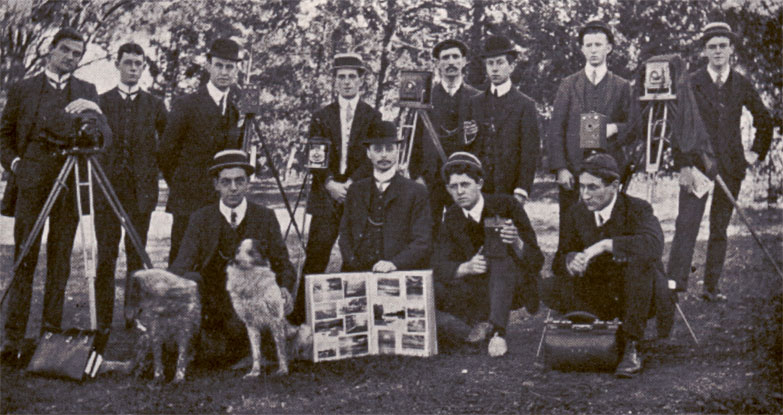
The photograph is of the Ashfield Camera Club. Henri Mallard is probably the one with the dogs, left of the .
Frank Hurley is the well dress young man with the camera to the right of the photo-album.
During his early years as a photographer, Frank Hurley participated in the amateur photographic societies in inner Sydney, mostly as a guest speaker, but also on occasion as a member of the committee.
These amateur societies were largely made up of camera enthusiasts, mostly from middle class backgrounds, who came together after hours and on Sundays, to share camera experiences, hold competitions and go on outings. Many would gather at lunch time at the KODAK or Harrington’s photographic stores in central Sydney to discuss latest developments.
The activities of the societies were reported regularly in journals such as the Australian Photo-Review, published by KODAK, and Harrington’s own magazine. Amongst the many names who served on committees and who made presentations on techniques, there are numerous mentions of Mr J. F. Hurley giving talks and demonstrations. His topics included photographing trains, night photography and making composites.
He was also reported as commenting on the industrial situation of the professional photographer whereby the industry was undergoing change due to industrial actions to obtain reasonable working conditions for lower paid workers.
At this stage of his career, Hurley was regarded as an active and adventurous professional as opposed to the many amateurs who actually held down a day job or in some cases, some have been independently wealthy. Hurley was one of the photographers who travelled out to the middle class suburb of Ashfield and assisted in establishing a new amateur society there.
Of interest is that the patron of this club was one Professor Edgeworth David, scientist and Antarctic explorer. This is the same person who, in a couple of years, would be recommending to Mawson that he think about employing a professional photographer for the 1911 Antarctic Expedition. The evidence points to Henri Mallard being approached but for whatever reason, ultimately Hurley’s name was put forward.
Trains
Frank Hurley did many photographs of trains. His stories tell of the daring adventures and risks he took to capture the trains on the move.
In this instance he relates how he learnt to stand on the track and time the approaching train. He says that he learnt to stand on the track to photograph such speeding expresses such as this one. He would take the photograph and jump clear at the last second.
Or so the story goes!
|
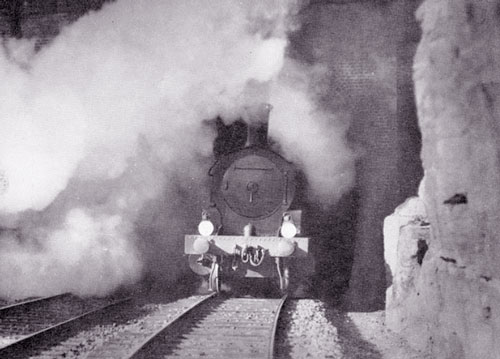 |
Night Photography
Frank Hurley took many night photos of harbour scenes and photographs of atmospheres of lakes and streams.
The technique of creating these shots more likely required late afternoon, low sun shots, which were later printed to look as though they were night photographers. They are early 'Day for Night' images as used later by cinema directors.
Vigil of the Night: This photo was accompanied by the emotive title of Vigil of the Night. This practice of applying such titles was very common with photographers worldwide. |
 |
Composites
In years to come, particularly during World War One, Frank Hurley would be accused of creating ‘fakes’. This accusation became particularly nasty in statements made about some of the images Hurley produced to tell the story of what he witnessed during his time in the trenches. This accusation of creating ‘fakes’ has continued into much of the history of Frank Hurley.
At the turn of the century, using multiple imagery or composites, was seen as part of the expertise of the photographer in producing a desired image of a scene or a portrait. In his own formative years around 1905 and 1906,
Hurley quickly learnt the skills to manipulate images to produce sets of photographs that were then printed as postcards, quickly snapped up by the general public. Hurley was just one of several new professionals, such as Harold Cazneaux, who gave talks and wrote articles during the first years of the century on manipulating negatives and achieving better skies and clouds in the final prints. The photographic journals of the time often had articles giving tips on manipulation and other techniques to improve the results.
Frank Hurley often manipulated his images. He did so as a photographer before the Mawson expedition and he continued the practice with pride for the rest of his career.
To assess Hurley’s large body of work, including the many composites he produced, one must put aside any set of criteria based on fine printing which came to dominate art photography as the 20th century progressed. Frank Hurley was more than just a professional photographer and hence brought to the task as many techniques and expertise as he had to hand. His work practices reflect more those of many digital image makers of today who use all sorts of clever tricks to produce an image the looks ‘real’.
There is little doubt, that Hurley would have loved computer manipulations and the use of applications such as Photoshop.
In a recent Sydney newspaper there were two photographs on opposite pages used as part of a large article. The captions used demonstrated that manipulation is alive and well. One photograph was credited as: ‘Photograph by …”.
While the second photograph had the caption: “Illustrated by …’. Using this example and applying it to Frank Hurley, and many others including Harry Phillips, the images were Real Photographs but on some occasions, the outcome was an ‘Illustration’ whereby the image had been manipulated and possibly the result of composites.
The label of ‘fakes’ has been unfortunate for Hurley especially given the probable political motive of those during the First World War who used the term in criticising Captain Hurley’s portrayal of the scenes in the front lines.
It is also sad that there are still many who perpetuate Hurley use of composites as a weakness. However, this is tempered with the fact that during his many years as a professional, his images were extremely popular and his reputation such that he was a family name.
Macquarie Lighthouse
Hurley told the story in his publications that this photograph was taken by staying out all night on a wet night. This photograph is very much an early example of how Hurley recreated what was not possible to photograph using the equipment of the time.
Hurley most likely took the photograph.
This could have been at night or could even have been during the day in silhouette against the sun. Hurley would have then altered the image using very standard practices to illustrate what he probably saw but could not capture on film. That is, the lines of light were most likely added later back in his studio. |
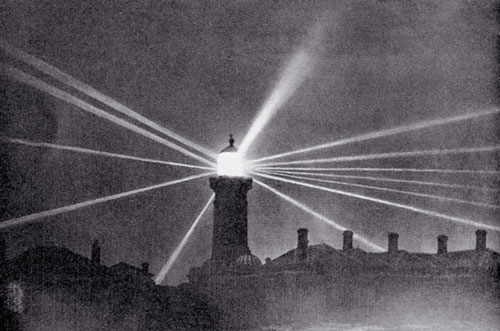
|
Harry Phillips
The young Frank Hurley knew Harry Phillips, the Blue Mountains photographer who was very active as a photographer and publisher in Katoomba after about 1909. Phillips, a printer, had moved to Ashfield in Sydney in 1905, but due to a series of accidents, stopped printing and took up photography.
Several links would have brought them together, for instance both had the printing industry links and Phillips would have had to visit Harrington’s and Kodak in central Sydney to advance his art. Their paths crossed and Harry Phillips and Frank Hurley became friends. This was to be one of the few close friendships that Frank was to maintain. They were to work together on several projects, the last known being on a film about the Blue Mountains, in the 1930s.
After Phillips moved his family in 1909 and set up a publishing and photographic in the Blue Mountains, he sent Hurley a photograph of clouds over the mountains. The story is that Hurley added in an aeroplane and sent the photograph back to Phillips. Later when Hurley returned from World War One, Hurley was reported as being on excursions in the Blue Mountains with Phillips, again a sign of a friendship.
Another very interesting collaboration was that one of Harry Phillip’s first publications was Sydney and Surrounding Areas, 71 Views. This publication includes several panoramic photographs as well a host of postcard size images. Many of the images can be identified as being possibly by Hurley, possibly the same images Hurley produced as cards.
Whether or not Hurley also produced them for other reasons is unknown at present. However, there is a group of images towards the rear of the publication that are simply reproductions of Hurley’s cards, all still signed, mostly with the initials JFH. There had to be a close working relationship for Phillips to use so many images without formally acknowledging the photographer as Hurley.
This photograph was originally by Harry Phillips. The plane was inserted by Frank Hurley.
Later in his life, Frank was in fact to fly over these same mountains in the company of Ross Smith.

|
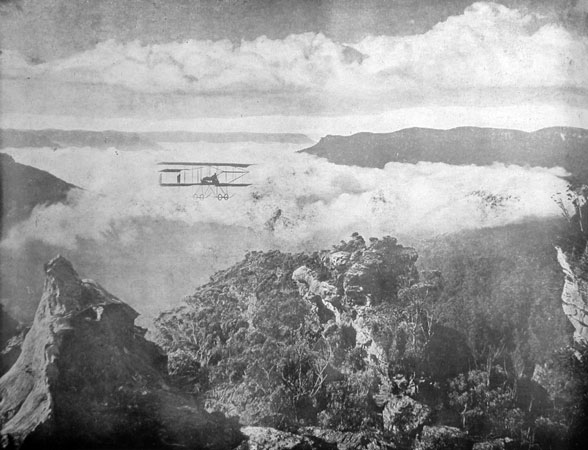
|
There is some evidence that Harry Phillips worked in a similar vein to professional photographers such as Frank. Postcards, with a Harry Phillips logo on the front, exist which have images of Sydney on the back, dating around 1908 –1909.
It seems that Harry Phillips, while living in Sydney, probably worked across the similar fields as Frank. It must also be noted that Harry lived in Ashfield, where Frank Hurley and Henri Mallard assisted in establishing The Ashfield Amateur Photographic Society.
The patron for the Ashfield Photographic society was Professor Edgeworth David, the same important public figure whop was to later recommend to Douglas Mawson that he include a photographer in his next party to the Antarctic, and that person ended up being Frank Hurley.
The opportunities for sharing ideas and trends were numerous. By this time Frank Hurley, or Mr J. F. Hurley, as he is reported, was a regular guest speaker at meetings of these societies, thus indicating his rise as a well-known professional. He lectured on many of his favourite subjects and techniques.
Clouds
Which brings us to ‘clouds’. both Harry Phillips and Frank Hurley loved to photograph clouds.
Once Harry Phillips commenced his Katoomba photographic and publishing work, he quickly established a reputation amongst the locals for chasing after clouds. The residents of Katoomba knew what sort of day would be good for Harry.
Phillips was a religious man, but questioned the role of the church. This was a common set of beliefs developed during the latter part of the 19th Century and several well known photographers demonstrated a belief in the almighty and the wonders of nature through images of clouds, sunsets and moonlit nights. On the last example, the moonlit night, it was an accepted 19th Century practice to establish such an image by pointing the camera directly at the sun when it was low in the sky, thus giving the effect of a night sky with the moon in the centre. Frank Hurley adopted this trickery into images he published on postcards.
Phillips believed that clouds held all sorts of stories. At one point he predicted that a ‘Great War’ was about to occur. This was in 1911. He also published a book, called “Clouds’ which is many of his previous photos of scenes with clouds dominating as well many which were essentially of clouds over high mountains and other scenic views whereby the clouds are the dominate feature. The book has a poem by Shelley, pages of text indicating Phillip’s religious beliefs as well as the set on predicting World War One. |
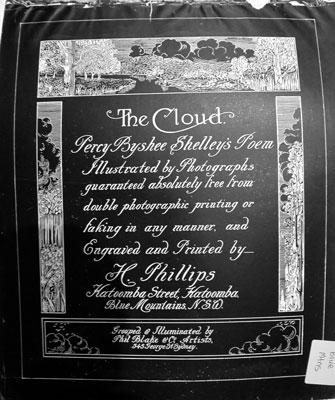
|
With Hurley and Phillips being close during these early years, it can only be speculated as to how they influenced each other.
It seems that Frank spent quite a bit of time in the Blue Mountains. The mountain towns had been popular for a decade or two for the people of Sydney to escape the metropolitan tensions. The clean fresh air of the mountains was marketed as supplying a means to regaining health and the rejuvenation of the human spirits. In the last years of the 19th Century this journey had been made easier with the opening of the famous Zig Zag railroad. And as was the case throughout NSW, whenever the railroad pushed through both tourism and commercial was enhanced.
Frank Hurley, followed the people and the transport routes, and took to the Blue Mountains as a source of images. He continued well into his life to revisit these sites to gather images for postcards, and later for his books and colour cards. One unverified account in a Blue Mountains collection has Frank Hurley as a resident of the mountains. This mistake, if it is, may have been based on his frequent visits and possibly on one of his liaisons with a household which saw him visit the same area so frequently that he was taken to be a local.
Both Hurley and Phillips were keen to use composites to illustrate a scene. Frank went on to produce a multitude of photographs, usually composites, with dramatic clouds. Clouds feature in his early photographs on postcards and in the few known photographs of the time.
Later in his career, he was known to have a bank of negatives of clouds ready to be inserted into pictures as required. Sometimes in even within the same book, he would use the same set of clouds to improve the images of different locations. Later image composites have some interesting touches. One has been spotted as having the scene in the Blue Mountains, but clouds that may have been dropped in from Palestine.
Assessing Frank Hurley within the 20th century
The comments on the prolific amount of photographs produced by Frank Hurley from about 1906 to his death in 1962 vary widely from wild enthusiasm to the dismissive. The debates surrounding his work, his style and practices reflect very much on the diversity of the medium itself. While photography sits comfortably within our society as a very user friendly medium of the masses, it has brought with this accessibility, a full load of complexities and surprises.
To discuss the work of Frank Hurley, one is quickly lead into a discussion about the medium, its uses, the interpretations and the complexities of the different expectations put on the medium. There is no doubt that many in the field would like photographers to be easily classified and thence to stay within the allocated boundaries recognised by their contemporaries. This habit of setting down the rules has been one of the medium’s crosses to be borne throughout the 20thCentury. And as we can imagine, it did not suit Frank Hurley to be worrying about any such restrictions.
He sought and achieved recognition through what he saw as being the ‘perfect’ picture, and through assignments that equally returned an income and gained wider public acceptance.
There is no doubt that Frank Hurley was very much the Showman first (Julian Thomas used the term Showman to describe Hurley in his book)
To achieve this he used an array of tools and opportunities including stills photography, film, books, radio and any chance to be centre stage.
While he is highly recognised as an outstanding Australian and as well known photographer of the 20th Century, this reputation is based on a mixture of reasons. It is this mix of image-maker, adventurer, author and ‘Showman’ that has kept him in the halls of fame. The result is that his work is now represented in a diversity of collections within cultural institutions. Within Australia his work has ended up in the full range including The National Gallery, the National Library, The Archives, The War Memorial, Screen Sound Australia, the Mitchell Library (Sydney) and the Mawson Institute in Adelaide.
The most common criticism, both implied and direct, is of his use of composites. Again, Frank Hurley’s aim was the final picture and the final story to be told. He was not of the ‘fine print’ school whereby the image captured has to remain sacred, not to be fiddled. Not that there are too many who can claim images unsullied by any process of manipulation. However in Frank Hurley’s case, the composite was a tool to bring together elements to deliver the message. This could be for propaganda, namely to tell everyone how wonderful Australia had become as a nation of achievers, to raise revenue for the Antarctic expeditions, or to send home the stories from the battle fields of World War One and Two.
Aesthetically his pictures were seen as being very much in the dramatic and romantic mode and as such proved very popular. Exhibitions of Frank Hurley’s work always attracted good crowds and continue to do so today. While some still snipe at the over-use of clouds etc, it seems that Frank Hurley knew his audience.
He was very much the artist-photographer who carried forward much of the aesthetics and practices from the 19th Century and combined them with ways of seeing in the early part of the 20th Century. |
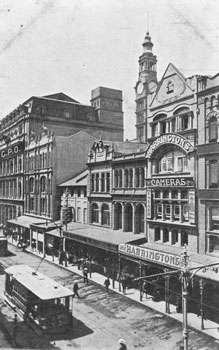
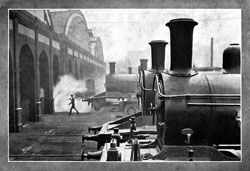
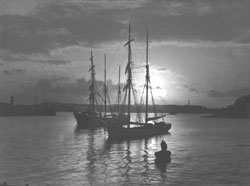
|
return to the Hurley menu page >>>> click here
|












